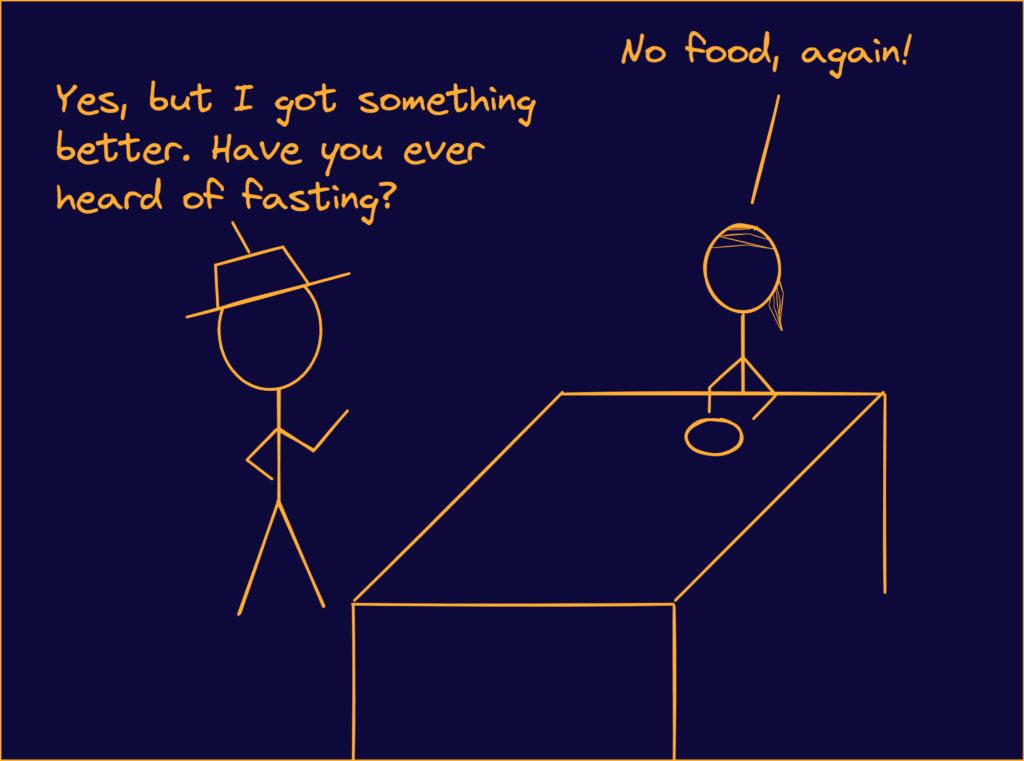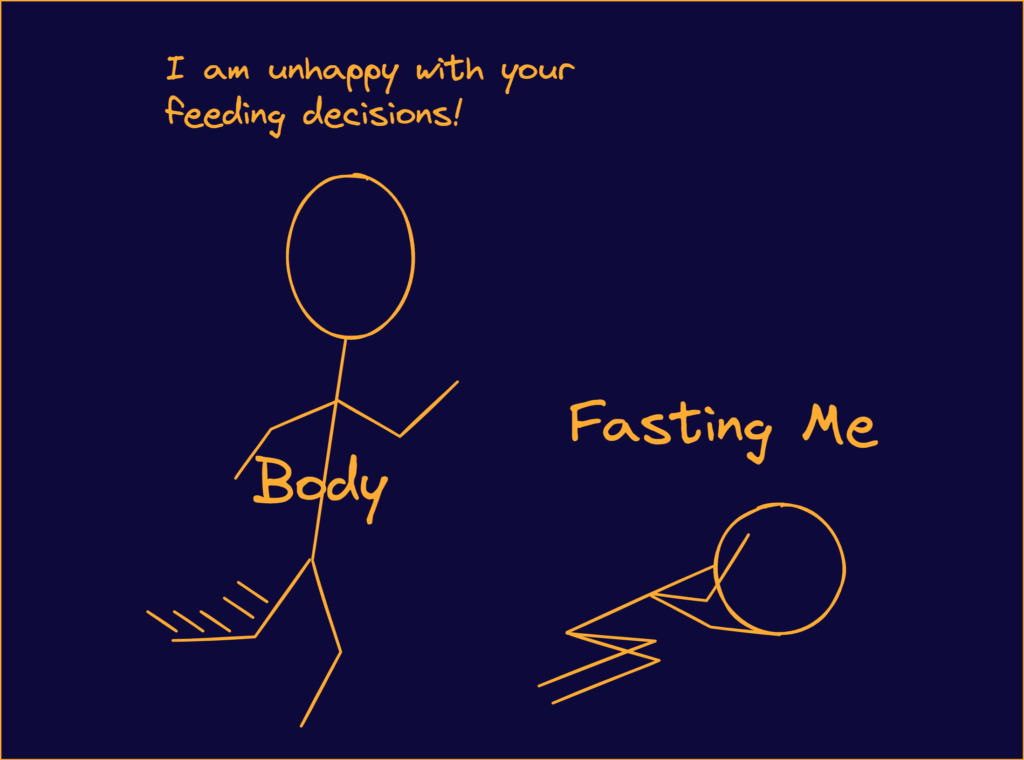Intro
Hey you! Yeah, you! You wanna learn something? Then let me tell you about a method that will blow off your bejeebis. What if I told you there was a way to boost your:
- weight loss [Goodrick 1983]
- strength and general fitness [Gotthardt 2016] [Mattson 2012]
- sleep [Sherman 2012].
- cognitive performance [Singh 2012]
- and more…
It is a method that is being conducted for thousands of years across species.
More or less voluntarily.
Fasting
Exactly, that invisible torture device people expose themselves to during lent, Ramadan or after they read the last self-improvement book / blog / media of your choice.
For those of you unfamiliar with the practice: Fasting is an age old, over countless centuries and cultures performed, forgotten and found again willful refrainment from eating, (sometimes) drinking and other such pleasantries of life over a prolonged period of time.
In the scope of this article, I am referring to the abstinence from food. When you feel hungry you might do it right. Might, because there are some caveats to it.
But before we get to those let me tell you a bit about the history of fasting, its benefits and then a quick “How does it?” do it before we get to the “How do I do it?”-part.
History of fasting
Nowadays, fasting is a culture phenomenon as prevalent in the fitness society as it in old school mid eastern and christian circles.
Perhaps even more.
New names and practices for fasting spring out of the ground faster than mushrooms in autumn.And they are picked equally as fast.
There is Alternate Day Fasting,12 hour Fasting, 16:8 Fasting Intermittent Fasting, 5:2-diet, Juice Fasting, One Meal a Day Fasting, Eat Stop Eat and more. This inflation of fasting techniques has its reason of course.
Even way back when, people noticed the macroscopic effects that a little abstinence from food brought with itself. The ancient Chinese, Greeks and Romans even suggested fasting for medical reasons [Kastner 1993]. The invention of fasting might have been a pure coincidence, but nobody knows how and when it truly happened.

What we do know is that fasting is a natural occurrence in the wild. Many animals haven’t yet adopted supermarkets which forces them to roam their respective hunting grounds.
Wolf packs for example have periods during which they only manage to put a successful meal together every one or two weeks. One could argue that they just adopted one of the more stringent fasting routines, or that the parents are going through difficult times. Be it as it may, their brains and bodies must continue to function at high levels even if the last meal has been days or weeks ago. And keen scientists and one or another animal-fan have observed that they do [MacNulty 2014].
The same applies of course to the myriad of species out there with similar eating habits and not just now, but throughout time. It is likely that before the invention of frozen and canned food, humans too had to turn to fasting [De Vynck 2016, Crittenden 2017].
At least that’s what they called it when they cried themselves to sleep.

And during those times our ancestors probably noticed one or another of the benefits that fasting brings with itself.
Benefits of fasting
The obvious of course being reduced body-weight [Goodrick 1983]. People who fast tend to lose body-fat. Far less obvious is that fasting also promotes muscle growth [Gotthardt 2016]. Putting one or another fasting-day (or half-a-day) into your workout might actually benefit your bulkiness. Also fasting benefits a good nights rest (aka sleep) by normalizing the circadian rhythm [Sherman 2012]. But those are just some of the basics. Let’s get to the good stuff that puts fasting into pharmaceutical companies’ black-book.
Doctors hate this one simple trick.
Because fasting not only makes us smarter by improving our learning and memory [Fontan-Lozano 2007, Li 2013, Singh 2012], it also makes our brain healthier. That includes protection against:
- Epilepsy [Bruce-Keller 1999]
- Alzheimer [Halagappa 2007]
- Dementia [Sinclair 2022-7]
- Strokes [Manzanero 2014]
And then there is the big benefit (gently called “BB”):
Fasting increases our life-span.
[Goodrick 1983]
That doesn’t mean you will be longer old to have more time to unhappily wither away. No, it means that you stay young and healthy for a longer time.
A quick look into how does fasting do
But, how does fasting do it? The short answer is that fasting affects the mechanisms in our bodies down to the expression of genes [Anton 2018]. The long answer sadly is too long to but it into this article.
Shameless advertisement for the next article.
How to fast
After reading all this, you might want to jump right in and give it a try, BUT stop right there. As stated before fasting has a few caveats and can even be dangerous.
Fasting can cause:
- nausea and vomiting [Harrison 1966]
- edema [Hermann 1968]
- alopecia and motor neuropathy [Rooth 1970]
- hyperuricemia and urate nephropathy [Munro 1972]
- abnormal liver function tests and decreased bone density [British Medical Journal 1978]
- thiamine deficiency and Wernicke’s encephalopathy [Devathasan 1982, Waterston 1986]
- mild metabolic acidosis [Ross 1969]
- death [Kerndt 1982]
and therefore proof all those concerned mothers right.
Although these effects have only been documented during fasts that lasted several weeks, not shorter ones [Varady 2011, Catenacci 2016], fasting should still be done with care.
In effect during fasting you deny your body nutrition and effectively mimic starving. Not only will every grandmother in the history of grandmothers but also your body have one or two things to say about this.

The bodies primary method to protest against fasting is hunger and let me tell you from experience:
Being hungry sucks.
Outro
But we will explore the topic of how to deal with hunger and fast effectively for shorter and longer times and explore the mechanisms that lead to all the benefits in the coming articles.
Stay tuned 😉
Sources
| Key | Citation |
|---|---|
| Anton 2018 | Anton, S. D., Moehl, K., Donahoo, W. T., Marosi, K., Lee, S. A., Mainous, A. G., 3rd, Leeuwenburgh, C., & Mattson, M. P. (2018). Flipping the Metabolic Switch: Understanding and Applying the Health Benefits of Fasting. Obesity (Silver Spring, Md.), 26(2), 254–268. https://doi.org/10.1002/oby.22065 |
| British Medical Journal 1978 | Fasting and obesity. (1978). British medical journal, 1(6114), 673. |
| Bruce-Keller 1999 | Bruce‐Keller, A. J., Umberger, G., McFall, R., & Mattson, M. P. (1999). Food restriction reduces brain damage and improves behavioral outcome following excitotoxic and metabolic insults. Annals of Neurology: Official Journal of the American Neurological Association and the Child Neurology Society, 45(1), 8-15. |
| Catenacci 2016 | Catenacci, V. A., Pan, Z., Ostendorf, D., Brannon, S., Gozansky, W. S., Mattson, M. P., … & Troy Donahoo, W. (2016). A randomized pilot study comparing zero‐calorie alternate‐day fasting to daily caloric restriction in adults with obesity. Obesity, 24(9), 1874-1883. |
| Crittenden 2017 | Crittenden, A. N., & Schnorr, S. L. (2017). Current views on hunter‐gatherer nutrition and the evolution of the human diet. American Journal of Physical Anthropology, 162, 84-109. |
| De Vynck 2016 | De Vynck, J. C., Anderson, R., Atwater, C., Cowling, R. M., Fisher, E. C., Marean, C. W., … & Hill, K. (2016). Return rates from intertidal foraging from Blombos Cave to Pinnacle Point: Understanding early human economies. Journal of Human Evolution, 92, 101-115. |
| Devathasan 1982 | Devathasan, G., & Koh, C. (1982). Wernicke’s encephalopathy in prolonged fasting. The Lancet, 320(8307), 1108-1109.” |
| Fontan-Lozano 2007 | Fontán-Lozano, Á., Sáez-Cassanelli, J. L., Inda, M. C., de los Santos-Arteaga, M., Sierra-Domínguez, S. A., López-Lluch, G., … & Carrión, Á. M. (2007). Caloric restriction increases learning consolidation and facilitates synaptic plasticity through mechanisms dependent on NR2B subunits of the NMDA receptor. Journal of Neuroscience, 27(38), 10185-10195. |
| Goodrick 1983 | Goodrick, C. L., Ingram, D. K., Reynolds, M. A., Freeman, J. R., & Cider, N. L. (1983). Differential effects of intermittent feeding and voluntary exercise on body weight and lifespan in adult rats. Journal of gerontology, 38(1), 36-45. |
| Gotthardt 2016 | Gotthardt, J. D., Verpeut, J. L., Yeomans, B. L., Yang, J. A., Yasrebi, A., Roepke, T. A., & Bello, N. T. (2016). Intermittent Fasting Promotes Fat Loss With Lean Mass Retention, Increased Hypothalamic Norepinephrine Content, and Increased Neuropeptide Y Gene Expression in Diet-Induced Obese Male Mice. Endocrinology, 157(2), 679–691. https://doi.org/10.1210/en.2015-1622 |
| Halagappa 2007 | Halagappa, V. K. M., Guo, Z., Pearson, M., Matsuoka, Y., Cutler, R. G., LaFerla, F. M., & Mattson, M. P. (2007). Intermittent fasting and caloric restriction ameliorate age-related behavioral deficits in the triple-transgenic mouse model of Alzheimer’s disease. Neurobiology of disease, 26(1), 212-220. |
| Harrison 1966 | Harrison, M., & Harden, R. (1966). The long-term value of fasting in the treatment of obesity. Lancet, 2, 1340-1342. |
| Hermann 1968 | Hermann, L. S., & Iversen, M. (1968). Death during therapeutic starvation. Lancet, 2. |
| Kastner 1993 | Kastner, M. A., & Burroughs, H. G. (1993). Alternative healing: The complete AZ guide to over 160 different alternative therapies. Halcyon. |
| Kerndt 1982 | Kerndt, P. R., Naughton, J. L., Driscoll, C. E., & Loxterkamp, D. A. (1982). Fasting: the history, pathophysiology and complications. Western Journal of Medicine, 137(5), 379. |
| Li 2013 | Li, L., Wang, Z., & Zuo, Z. (2013). Chronic intermittent fasting improves cognitive functions and brain structures in mice. PloS one, 8(6), e66069. |
| MacNulty 2014 | MacNulty, D. R., Tallian, A., Stahler, D. R., & Smith, D. W. (2014). Influence of group size on the success of wolves hunting bison. PloS one, 9(11), e112884. |
| Manzanero 2014 | Manzanero, S., Erion, J. R., Santro, T., Steyn, F. J., Chen, C., Arumugam, T. V., & Stranahan, A. M. (2014). Intermittent fasting attenuates increases in neurogenesis after ischemia and reperfusion and improves recovery. Journal of Cerebral Blood Flow & Metabolism, 34(5), 897-905. |
| Mattson 2012 | Mattson M. P. (2012). Energy intake and exercise as determinants of brain health and vulnerability to injury and disease. Cell metabolism, 16(6), 706–722. https://doi.org/10.1016/j.cmet.2012.08.012 |
| Munro 1972 | Munro, J. F., & Duncan, L. J. (1972). Fasting in the treatment of obesity. The Practitioner, 208(246), 493-498. |
| Rooth 1970 | Rooth, G., & Carlström, S. (1970). Therapeutic fasting. Acta medica scandinavica, 187(1‐6), 455-463. |
| Ross 1969 | Ross, S. K., Macleod, A., Ireland, J. T., & Thomson, W. S. (1969). Acidosis in obese fasting patients. British Medical Journal, 1(5640), 380. |
| Sherman 2012 | Sherman, H., Genzer, Y., Cohen, R., Chapnik, N., Madar, Z., & Froy, O. (2012). Timed high‐fat diet resets circadian metabolism and prevents obesity. The FASEB Journal, 26(8), 3493-3502. |
| Singh 2012 | Singh, R., Lakhanpal, D., Kumar, S., Sharma, S., Kataria, H., Kaur, M., & Kaur, G. (2012). Late-onset intermittent fasting dietary restriction as a potential intervention to retard age-associated brain function impairments in male rats. Age, 34, 917-933. |
| Varady 2011 | Varady, K. A. (2011). Intermittent versus daily calorie restriction: which diet regimen is more effective for weight loss?. Obesity reviews, 12(7), e593-e601. |
| Sinclair 2022-7 | David Sinclair. (2022, February 16). The Science of Keeping the Brain Healthy | Lifespan with Dr. David Sinclair #7[Video]. YouTube. https://www.youtube.com/watch?v=XXtioWl9BWg |
| Waterston 1986 | Waterston, J. A., & Gilligan, B. S. (1986). Wernicke’s encephalopathy after prolonged fasting. |


Leave a Reply